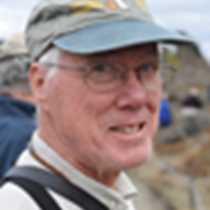Pleneau & Petermann Islands, Antarctica
During the evening we made our way back up Crystal Sound, along the west coast of the Antarctic Peninsula, as we returned from our dash to the Antarctic Circle. Our morning outing was at Pleneau Island. The surface of the island has been smoothed and rounded by the passage of glaciers, not once but many times, leaving behind some of the best walking rock in Antarctica. It was a fine chance to stretch our legs and make our way to the top of the island, past neighborhoods of breeding gentoo penguins, deep green moss beds, and expanses of pink snow. (Yes, indeed: pink snow, stained by an abundant growth of snow algae.) The view from the top was stunning – large icebergs stranded in shallow water and a flotilla of yellow watercraft exploring the scene: they were our kayaks, deployed for a second time. Curious paddlers approached wildlife for a better view, and curious wildlife approached paddlers, swimming around and under the kayaks in an impressive display of aquatic agility.
Over lunch we moved a short distance to Petermann Island, where the Oceanites Antarctic Site Inventory Project has an intensive study site. Oceanites is a conservation partner of Lindblad Expeditions and the National Geographic Society. They combine ship-based counts of penguins and other breeding birds at sites visited by the National Geographic Endeavour with more intensive monitoring of nesting success here at Petermann Island. We visited the small village of yellow tents where three scientists live and work, dividing their time between camp maintenance duties, visiting their study colonies, and data entry. Petermann Island supports breeding Adelie and gentoo penguins. As elsewhere along the Peninsula, the Adelies are declining and the gentoos are increasing. The working hypothesis relates the changes in penguin populations to warming of the climate along the Peninsula as this affects availability of winter habitat for the two species. Blue-eyed (=Antarctic) shags, the cormorants of the far south, are also in decline for reasons as yet unknown. Here we had our best looks at these birds. With up to four young in a brood, it took a lot of coming and going by the adults with the large, dark chicks aggressively demanding to be fed each time an adult returned to the nest.
Over dinner the Oceanites scientists joined us aboard National Geographic Endeavour and shared their tales of life in an Antarctic field camp.
During the evening we made our way back up Crystal Sound, along the west coast of the Antarctic Peninsula, as we returned from our dash to the Antarctic Circle. Our morning outing was at Pleneau Island. The surface of the island has been smoothed and rounded by the passage of glaciers, not once but many times, leaving behind some of the best walking rock in Antarctica. It was a fine chance to stretch our legs and make our way to the top of the island, past neighborhoods of breeding gentoo penguins, deep green moss beds, and expanses of pink snow. (Yes, indeed: pink snow, stained by an abundant growth of snow algae.) The view from the top was stunning – large icebergs stranded in shallow water and a flotilla of yellow watercraft exploring the scene: they were our kayaks, deployed for a second time. Curious paddlers approached wildlife for a better view, and curious wildlife approached paddlers, swimming around and under the kayaks in an impressive display of aquatic agility.
Over lunch we moved a short distance to Petermann Island, where the Oceanites Antarctic Site Inventory Project has an intensive study site. Oceanites is a conservation partner of Lindblad Expeditions and the National Geographic Society. They combine ship-based counts of penguins and other breeding birds at sites visited by the National Geographic Endeavour with more intensive monitoring of nesting success here at Petermann Island. We visited the small village of yellow tents where three scientists live and work, dividing their time between camp maintenance duties, visiting their study colonies, and data entry. Petermann Island supports breeding Adelie and gentoo penguins. As elsewhere along the Peninsula, the Adelies are declining and the gentoos are increasing. The working hypothesis relates the changes in penguin populations to warming of the climate along the Peninsula as this affects availability of winter habitat for the two species. Blue-eyed (=Antarctic) shags, the cormorants of the far south, are also in decline for reasons as yet unknown. Here we had our best looks at these birds. With up to four young in a brood, it took a lot of coming and going by the adults with the large, dark chicks aggressively demanding to be fed each time an adult returned to the nest.
Over dinner the Oceanites scientists joined us aboard National Geographic Endeavour and shared their tales of life in an Antarctic field camp.



